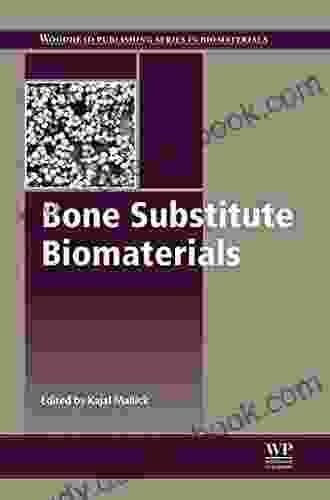Bone Substitute Biomaterials: A Comprehensive Guide to the Latest Advancements in Tissue Engineering and Regenerative Medicine

Bone substitute biomaterials are materials that are used to replace or repair damaged or diseased bone tissue. They play a crucial role in tissue engineering and regenerative medicine, providing a framework for bone growth and repair. Bone substitute biomaterials can be derived from a variety of sources, including natural materials such as bone grafts, synthetic materials such as ceramics and polymers, and composites that combine natural and synthetic materials.
5 out of 5
| Language | : | English |
| File size | : | 7225 KB |
| Text-to-Speech | : | Enabled |
| Screen Reader | : | Supported |
| Enhanced typesetting | : | Enabled |
| Print length | : | 352 pages |
The ideal bone substitute biomaterial should possess a number of properties, including:
* Biocompatibility: The material should not cause any adverse reactions in the body. * Osteoconductivity: The material should allow bone cells to attach and grow on its surface. * Osteoinductivity: The material should stimulate the body to produce new bone. * Mechanical strength: The material should be strong enough to withstand the forces of weight-bearing. * Porosity: The material should have a porous structure that allows for bone ingrowth.
Types of Bone Substitute Biomaterials
There are a number of different types of bone substitute biomaterials, each with its own unique properties and applications. Some of the most common types include:
* Autografts: Autografts are bone grafts that are taken from the patient's own body. They are the gold standard for bone grafting, as they have a high success rate and are associated with minimal complications. However, autografts can be limited in supply, and they may require a second surgical procedure to harvest the bone. * Allografts: Allografts are bone grafts that are taken from a donor. They are less successful than autografts, but they are still a viable option for bone grafting. Allografts are typically processed to remove any living cells, which reduces the risk of rejection. * Xenografts: Xenografts are bone grafts that are taken from a different species. They are less successful than autografts and allografts, but they may be an option for patients who cannot receive human bone grafts. Xenografts are typically processed to remove any living cells, which reduces the risk of rejection. * Synthetic bone substitutes: Synthetic bone substitutes are made from materials such as ceramics, polymers, and composites. They are designed to mimic the properties of natural bone, and they can be used to fill defects or to replace damaged bone. Synthetic bone substitutes are often used in combination with autografts or allografts.
Applications of Bone Substitute Biomaterials
Bone substitute biomaterials are used in a variety of clinical applications, including:
* Bone grafting: Bone grafting is a surgical procedure in which bone is transplanted from one part of the body to another. Bone grafting is used to treat a variety of conditions, including fractures, bone defects, and spinal fusion. * Dental implants: Dental implants are artificial teeth that are placed in the jawbone. Bone substitute biomaterials are used to fill in the space around the implant and to promote bone growth. * Orthopedic surgery: Bone substitute biomaterials are used in a variety of orthopedic surgeries, including joint replacements, spinal fusion, and fracture repair.
Bone substitute biomaterials play a critical role in tissue engineering and regenerative medicine, providing a framework for bone growth and repair. The ideal bone substitute biomaterial should possess a number of properties, including biocompatibility, osteoconductivity, osteoinductivity, mechanical strength, and porosity. There are a number of different types of bone substitute biomaterials, each with its own unique properties and applications.
Bone substitute biomaterials are used in a variety of clinical applications, including bone grafting, dental implants, and orthopedic surgery. As research continues to advance, new and innovative bone substitute biomaterials are being developed that are even more effective and versatile. These advances are helping to improve the lives of patients who suffer from bone damage or disease.
5 out of 5
| Language | : | English |
| File size | : | 7225 KB |
| Text-to-Speech | : | Enabled |
| Screen Reader | : | Supported |
| Enhanced typesetting | : | Enabled |
| Print length | : | 352 pages |
Do you want to contribute by writing guest posts on this blog?
Please contact us and send us a resume of previous articles that you have written.
 Page
Page Chapter
Chapter Text
Text Story
Story Reader
Reader Paperback
Paperback Magazine
Magazine Newspaper
Newspaper Bookmark
Bookmark Shelf
Shelf Glossary
Glossary Synopsis
Synopsis Footnote
Footnote Scroll
Scroll Tome
Tome Classics
Classics Library card
Library card Biography
Biography Autobiography
Autobiography Reference
Reference Thesaurus
Thesaurus Narrator
Narrator Librarian
Librarian Card Catalog
Card Catalog Borrowing
Borrowing Stacks
Stacks Archives
Archives Research
Research Lending
Lending Reserve
Reserve Journals
Journals Reading Room
Reading Room Rare Books
Rare Books Special Collections
Special Collections Interlibrary
Interlibrary Study Group
Study Group Thesis
Thesis Dissertation
Dissertation Awards
Awards Textbooks
Textbooks Wayne Howell
Wayne Howell Robert D Romanyshyn
Robert D Romanyshyn Annelise Orleck
Annelise Orleck Sally Brown
Sally Brown John Russell Brown
John Russell Brown Valeria Rossi
Valeria Rossi Tim Parsons
Tim Parsons Amber Richards
Amber Richards Karen Bojar
Karen Bojar Deb Kastner
Deb Kastner Xuanyi Chew
Xuanyi Chew Rebecca Felix
Rebecca Felix Keith Baker
Keith Baker Margaret Frazer
Margaret Frazer Suzanne Kelman
Suzanne Kelman Charlie Lyndhurst
Charlie Lyndhurst Wendy Christensen
Wendy Christensen Buddhist Text Translation Society
Buddhist Text Translation Society Neil Hanson
Neil Hanson Ben Greenman
Ben Greenman
Light bulbAdvertise smarter! Our strategic ad space ensures maximum exposure. Reserve your spot today!
 Dominic SimmonsFollow ·6.3k
Dominic SimmonsFollow ·6.3k Arthur Conan DoyleFollow ·15.8k
Arthur Conan DoyleFollow ·15.8k Anthony BurgessFollow ·13.2k
Anthony BurgessFollow ·13.2k Hayden MitchellFollow ·7k
Hayden MitchellFollow ·7k Raymond ChandlerFollow ·3.5k
Raymond ChandlerFollow ·3.5k Adam HayesFollow ·3.6k
Adam HayesFollow ·3.6k Dwight BlairFollow ·5.2k
Dwight BlairFollow ·5.2k Blake KennedyFollow ·4.5k
Blake KennedyFollow ·4.5k

 Dominic Simmons
Dominic SimmonsIcky Island: An Unforgettable Adventure for Kids!
Introducing Icky Island: A Delightful One...

 Carlos Fuentes
Carlos FuentesThe Midnight Breed: Embracing the Shadows and Unlocking a...
Welcome to the captivating world of...

 Ike Bell
Ike BellTwelve Steps Toward Political Revelation: A Path to...
Politics, often perceived as a complex and...

 Cameron Reed
Cameron ReedTravels in Arizona Goldfield: Unraveling the Threads of...
Nestled amidst the rugged...

 John Grisham
John GrishamFlashpoints of Cinema History and Queer Politics:...
The relationship between cinema history and...
5 out of 5
| Language | : | English |
| File size | : | 7225 KB |
| Text-to-Speech | : | Enabled |
| Screen Reader | : | Supported |
| Enhanced typesetting | : | Enabled |
| Print length | : | 352 pages |














